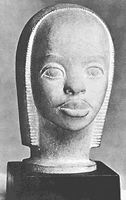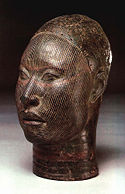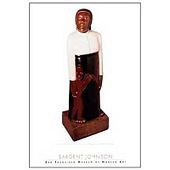| wiki | search |
Main Page | Groups and Assignments | Bios | History | Harlem | Diversity Today | Help
Harlem Renaissance artists experienced difficulty in producing art for the public. Their race was a burden to their success. White American artists were not very fruitful at the time, so they doubted that black Americans could be. Black artists had to convince themselves and the public that they have something important to express and the skills to do so.
Sargent Johnson
Harlem Renaissance art displayed a lot of traditional African art techniques. One sculptor, Sargent
Johnson, integrated African techniques with his own style and purpose. He made a lot of terracotta, porcelain, and wooden figures of heads of children. These artworks resembled African bronze sculptures of heads of kings during the Ife period, 1000-1500 A.D. The figures had large, almond-shaped eyes, broad noses, and full lips.
Johnson's renowned work, Forever Free (1933), of which he made many copies, is a sculpture of a black woman standing perfectly straight with her arms to her side. Her arms, filled with strength, cover and shield two black children, who are carved reliefs. Her face, filled with hope, is tilted upward toward the sky. This piece symbolizes Black Americans' perseverance to fight for and retain freedom.
Aaron Douglas
Aaron Douglas, a major Harlem Renaissance artist, was greatly influenced by Africanism. Like the Africans, he emphasized design more than subject in his artwork. He sought to express the spiritual identity of African Americans through his later artwork. He believed that all black men, whether from Africa or from America, were united as one soul. Aaron Douglas’s four-panel mural, Aspects of Negro Life (1934), narrates the story of the African American from his ancestral birth in Africa to his bondage in America to his emancipation to his freed, but difficult and oppressed, life in urban, industrial America. He used dark, flat colors, such as shades of green, brown, and black to paint this piece. His silhouette figures are two-dimensional, faceless, symbolic, generic, and ethnic, but they do not fail to evoke emotion.




